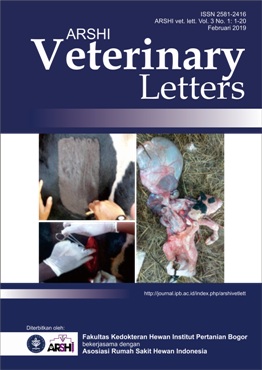Gambaran kristal urin pada hewan model nefrolitiasis hasil induksi etilen glikol
Abstract
Tingginya tingkat keterulangan kasus urolitiasis baik pada hewan maupun manusia, menuntut penelitian dalam mencari solusi menurukan angka keterulangan. Penelitian urolitiasis membutuhkan hewan model urolitiasis yang sesuai dengan kondisi sebenarnya. Salah satu metode yang digunakan adalah menciptakan kondisi hiperoksaluria. Penggunaan induksi etilen glikol menjadi metode yang paling umum digunakan. Induksi ini menghasilkan kristal kalsium oksalat monohidrat.
Downloads
References
Fan J, Glass MA, Chandhoke PS. 1999. Impact of ammonium chloride administration on a rat ethylene glycol urolithiasis model. Scanning Microsc. 13: 299-306.
Green ML, Hatch M, Freel RW. 2005. Etylen glycol induces hyperoxaluria without metabolic acidosis in rats. Am J Physiol Renal Physiol. 289: F536-F543.
Stoller ML, Meng MV.2007. Urinary Stone Disease: The Practical Guide to Medical and Surgical Management. New Jersey: Humana Press.
Thakur l, Uppal G, Sitapara N. 2013. In-vitro and in vivo models of urolithiasis. Inter J of Pharm Res. 5(1):1-5
Tondok MEB, Monoarfa A, Limpeleh H. 2014. https: //ejournal.unsrat.ac.id/index.php/eclinic/article/download/3722/3245.
Copyright (c) 2019 CC-BY-SA

This work is licensed under a Creative Commons Attribution-ShareAlike 4.0 International License.
Authors who publish with this journal agree to the following terms:
1. Authors retain copyright and grant the journal right of first publication with the work simultaneously licensed under a Creative Commons Attribution License that allows others to share the work with an acknowledgement of the work's authorship and initial publication in this journal.
2. Authors are able to enter into separate, additional contractual arrangements for the non-exclusive distribution of the journal's published version of the work (e.g., post it to an institutional repository or publish it in a book), with an acknowledgement of its initial publication in this journal.
3. Authors are permitted and encouraged to post their work online (e.g., in institutional repositories or on their website) prior to and during the submission process, as it can lead to productive exchanges, as well as earlier and greater citation of published work (See The Effect of Open Access).


.jpg)















